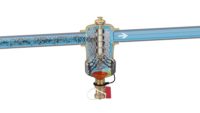The song “Georgia on my Mind” keeps running through my head, only it’s changed to “PEX on my Mind!”
Historical radiant: In 1946, a housing development sprung to live in Levittown, New York. They were radiantly heated using copper tubing embedded in concrete. Dan Holohan details how and why radiant heating was chosen and that these were the first homes in the USA to be radiantly heated. In the article, you’ll read that the oil-fired boilers were produced by York-Shipley. Mr. Shipley was one of our customers and a true gentleman who always took the time to talk with us whenever we worked in his home. The engineers from York-Shipley would fly to Levittown often to check up on the radiant systems installation and came back to York, Pennsylvania wondering why don’t we have a developer utilize the same radiant system for housing right here in our hometown.
Roy Sanders was one of the engineers and he became a dear friend and mentor. I first met Roy shortly after I ventured out on my own in 1979. Sanders had a reputation as a steam expert, and I had just installed my first on-my-own steam boiler. It was a direct replacement in a row home and I piped the supply and return exactly as the old boiler was set up. To my abject horror, whenever the new boiler fired up and had barely begun to produce steam, the water self-evacuated and my sphincter would do the mambo! No matter what I tried, I got the same result. Someone suggested I call Roy Sanders. I did and he volunteered to visit the installation. As long as I live, I will never forget that visit. Sanders was only halfway down the outside cellar steps when he pronounced he knew what was wrong! We met up at the boiler, he pulled the I&O manual from its protective sleeve, opened it to the near-boiler piping-diagram, and said do this exactly as illustrated and your steam boiler will behave. I expect I was probably blushing from embarrassment, but Roy never once denigrated me for being the idiot I was that day. He also refused to charge me any money. As I would come to know over many decades of friendship, that was quintessential Roy Sanders — always willing to share his knowledge and help fellow contractors.
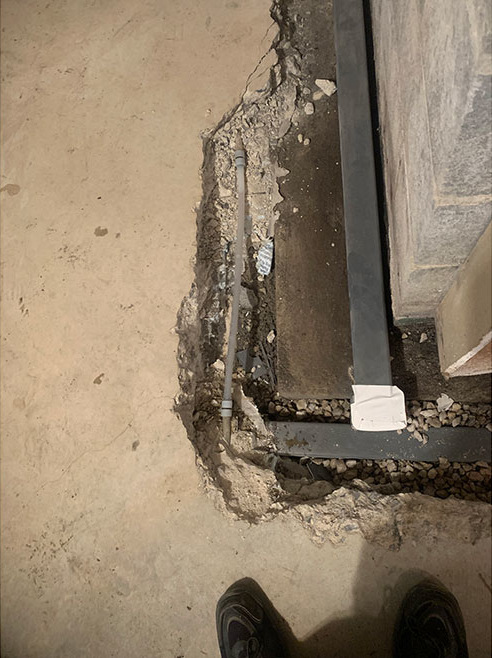
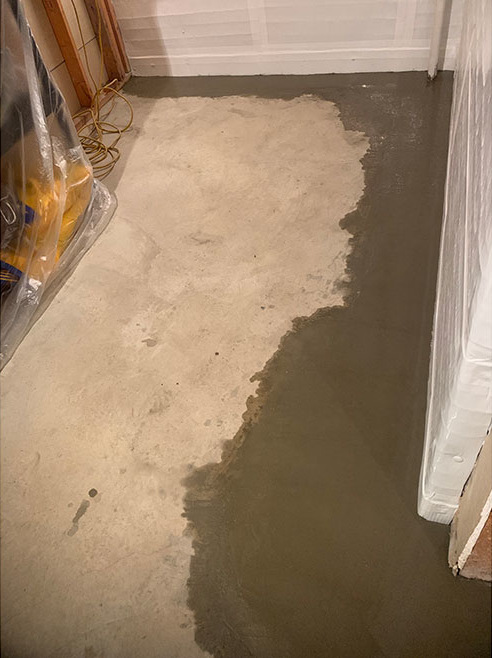
The basement concrete block walls eventually began taking on water after the sprayed-on tar along the exterior ended up no longer being completely waterproof. To fix the issue, workers had to break up concrete around the perimeter, drill holes in every web at the base of the blocks where they sit on the concrete footers, and install another collection system that would lead to a sump pit. Preferably, without damanging the radiant heating system within the floors!
They did build a radiant development here in York called Fireside that was a carbon copy of the Levittown homes. And, just like Levittown, they began springing leaks in the early 1970s, just as I had entered the trades as an apprentice. My job was to use what looked like an old-time phone earpiece with a pointed nail-like end you rested on the floor while listening for the pshhhhhhh sound. Dig here! In a few cases, after breaking up the concrete floor, the long-term hydronic leak had created a cavern large enough that I could work from below the floor! The copper tubing was always pitted from corrosion, which often made soldering or brazing more challenging. Eventually — just like Levittown — we had to abandon the radiant system and install hot water baseboard heating.
There was another 1940s era radiant sheriff in our town by the name of Architect Jack Spotts. Spotts took an entirely different approach to hydronic embedded tubing by using black iron piping. Systems were either threaded or welded and Spotts always provided meticulous detailed drawings. Many of those homeowners were our customers and Spotts was a family friend. Unfortunately, Spotts passed away just as I was entering the trades in 1972 and I never had the opportunity to learn why he decided on hydronic radiant with black iron piping. Many of those systems survived and remain in use today. I did learn that black iron and concrete apparently have the same coefficient of expansion, so far less stress between the tubing and concrete.
Even so, we did need to break up concrete and repair just a few of the Spotts hydronic radiant black iron tubes. By that time, we had a top-notch Flir infrared camera to aid in detection and on cold start-ups, any leak would look like someone had spilled a bucket of bright red paint on the floor! No longer any need to ask where the pets liked to lay on the floor or wet mop ceramic tiled flooring to see where a dry area developed first.
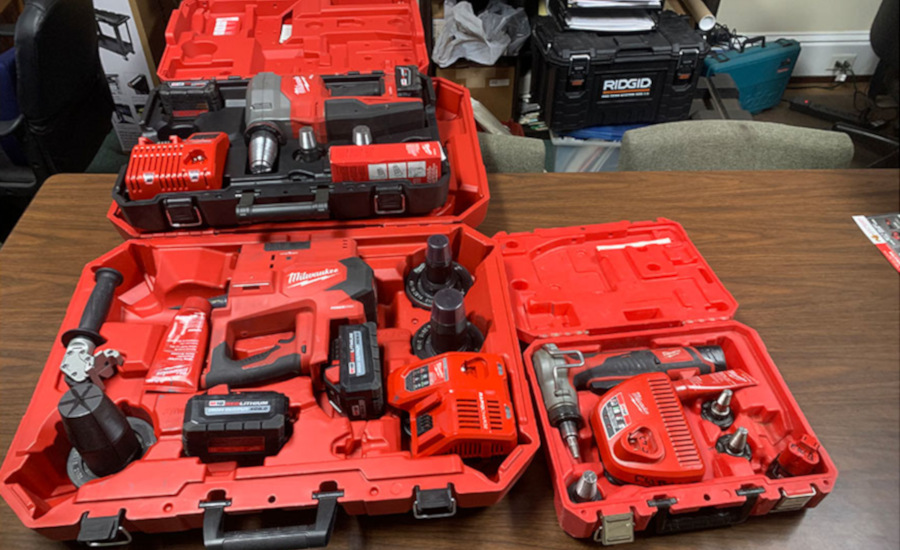
With incredible foresight, Dave Yates had the Milwaukee Tool PEX expander and Uponor ProPEX fittings on hand to fix any damages in case they occured.
In the 1990s, PEX tubing led the revival of hydronic radiant installations here in the U.S. after its import to our shores by Tomas Lenman, aka Mr. PEX. In the 1980s. Lenman developed the first cross-linked PEX tubing! I was fortunate to know Lenman via my membership in the RPA and today, the company he founded is in great hands with Jan Anderrsson as its president and a great friend/mentor, too.
When we decided to build our forever home in 1992-1993, I was determined it would be 100% radiantly heated. I had heard first-hand testimony from enough customers extolling the virtues of luxurious comfort they enjoyed, and read enough by folks like Richard Trethewey, Dan Holohan, and John Siegenthaler to know deep down that I’d be an even bigger idiot than the one Roy Sanders met long ago if I did not incorporate hydronic radiant heating. Little did I know, at that time, that all three would become great friends!
We decided on 10 zones of hydronic radiant utilizing Wirsbo HE PEX-a (now known as Uponor) with more than two miles of tubing because I also wanted tubing spaced closely together so I would have lower water temperatures on non design-day conditions. Trethewey, a keynote speaker at a Comfortech Convention, talked about energy conservation by lowering hydronic water temperature and stated that for every 3° F we lower the temperature of the water, there will be a 1% reduction in operating costs. Siggy (aka Siegenthaler) spoke and wrote frequently about energy conservation on the electrical side of hydronics, which struck a chord, too. My original 10 zones plus an 11th zone for the indirect hot water storage tank, incorporated two high-head circulators in series because my home is also my lab. The boiler had high resistance to flow and every zone had its own circulator. It’s a wonder our electric meter didn’t sail off like a Frisbee! My mechanical room makeover incorporated two ECM Delta-P circulators, 10 low-watt zone valves and an ultra high-efficiency modulating condensing boiler.
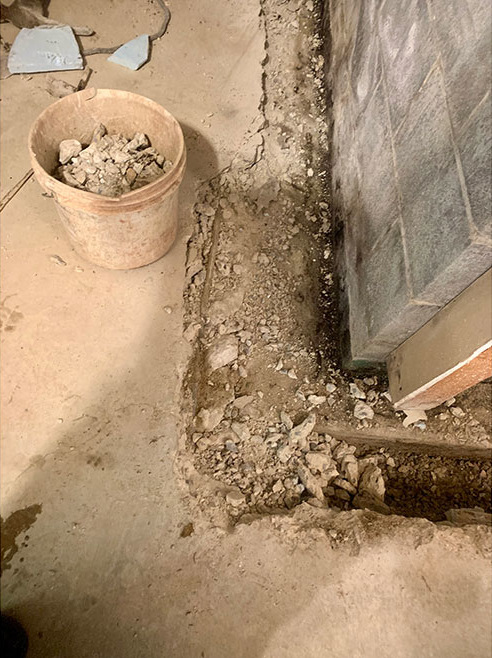
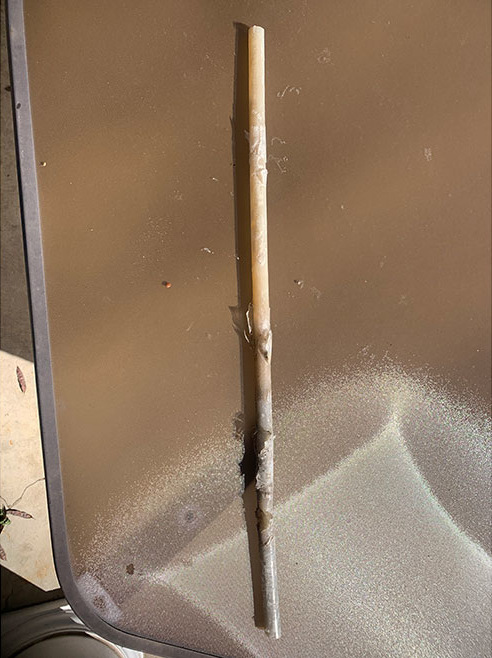
Damaged PEX from the radiant heating system in the basement of the Yates home.
I never once ever thought I’d be faced with damages to my embedded PEX-a Wirsbo/Uponor tubing, yet there I was just a few days ago staring at a mangled and punctured section of one loop! When we built our forever home, I added 1,200-feet of perforated drainage piping under the slab because water coming in contact would strip away the heat energy and our radiant system would be a failure — and no way I was going to let that happen! Atop the crushed stone, I installed a 4-mill plastic vapor barrier with 2-inch high-density Dow boards and then a 6x6 metal wire-mesh grid using flat sheets because I had seen pictures and read about the rolls not wanting to lay flat and problems that generated.
What I did not know then (sure wish I had) was our concrete block walls would eventually take on water after the sprayed-on tar along the exterior ended up no longer being completely waterproof. That produced effervescence and mold on the blocks surface in our back two storage rooms. It would be necessary to break up concrete around the perimeter, drill holes in every web at the base of the blocks where they sit on the concrete footers, and install another collection system that would lead to a sump pit.
We decided on 10 zones of hydronic radiant utilizing Wirsbo HE PEX-a (now known as Uponor) with more than two miles of tubing because I also wanted tubing spaced closely together so I would have lower water temperatures on non design-day conditions.
No worries! In spite of the crew not remembering my admonitions and communication in the morning, they forgot and strayed out too far from the block wall where the hit my PEX-a tubing. I had anticipated this event and had closed the isolation valves for that loop, so very little water was lost and the remainder of our hydronic system was unaffected. One distinct advantage of having utilized Wirsbo/Uponor PEX-a tubing is it can be expanded for using their ProPEX fittings. I had preordered Uponor ProPEX fittings, rings and a coil of tubing and borrowed one of the Milwaukee expander tools I had purchased when I owned F. W. Behler. Easy-peasy: Snip-snip cut out the affected section, slide on two PEX rings, expand our 31-year-old PEX-a tubing and insert couplings, cut a new piece of PEX and expand its ends to simply slide over the ProPEX couplings. The total elapsed time was just over 1-minute.
I was delighted to find the more than three decades old PEX-a tubing was as resilient and pliable as was the brand new Uponor tubing! Pressure tests performed and leak-free, so hours later the new concrete floor had been poured and the basement dry folks were on to their next job. Since I had only opened on of the loop’s isolation valves, I was able to dismantle the Wirsbo copper-to-PEX transition fitting and flush that loop before placing it back into service.



